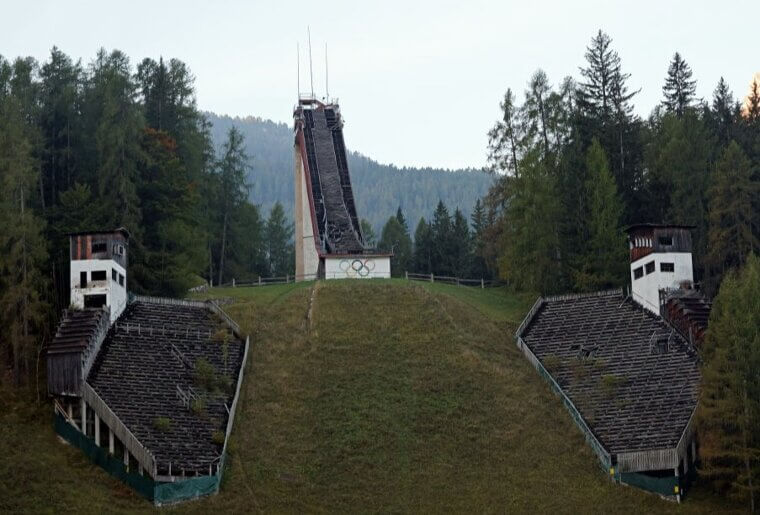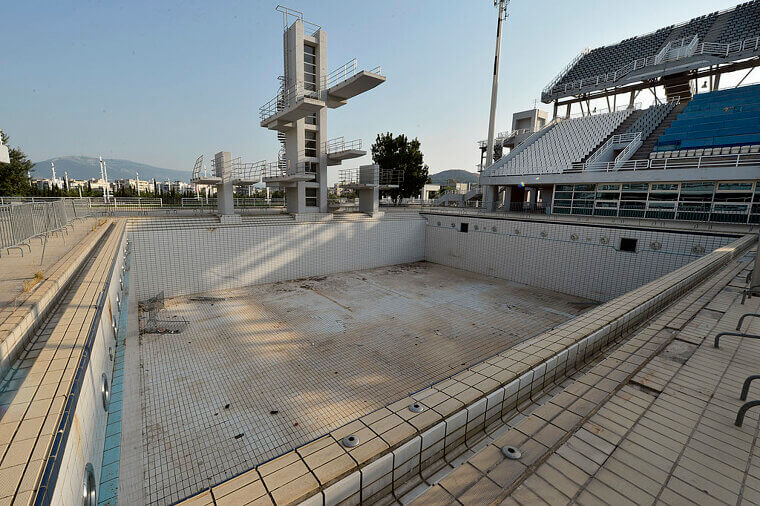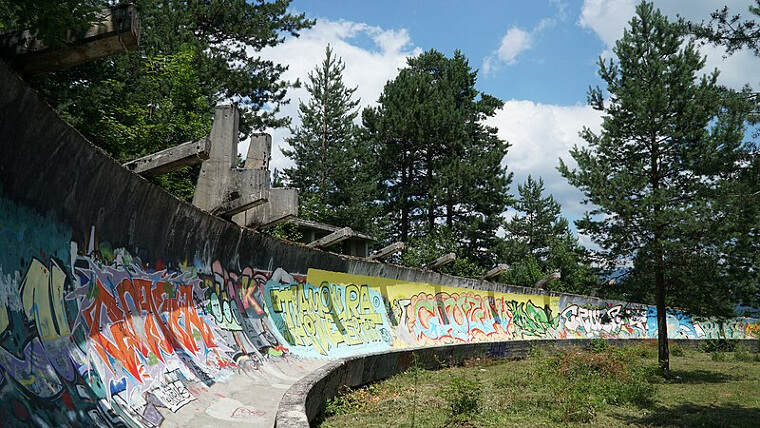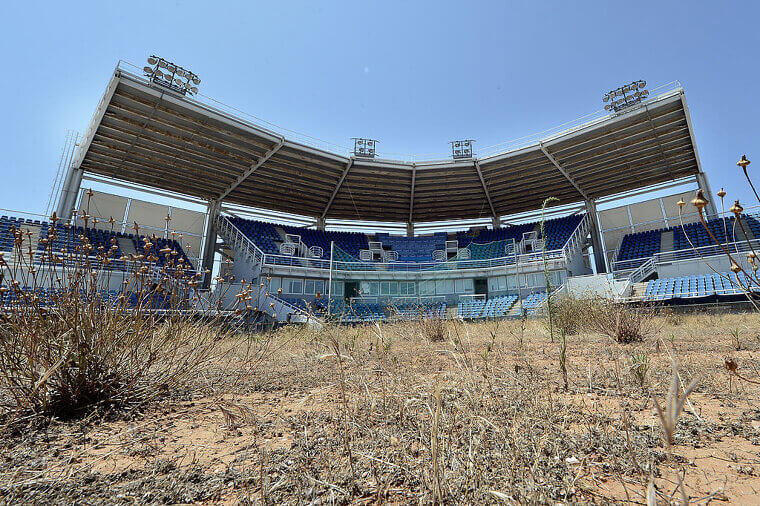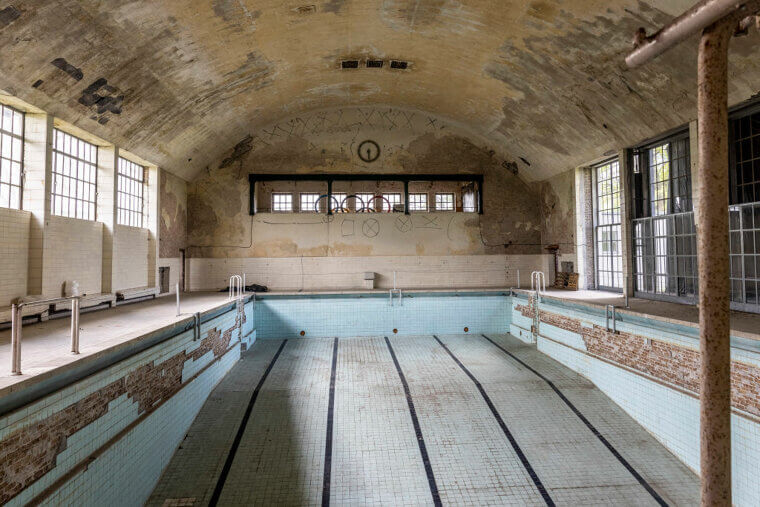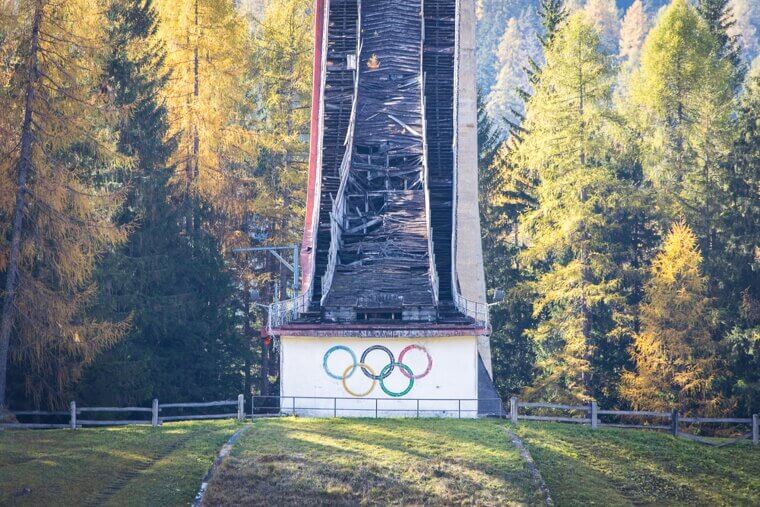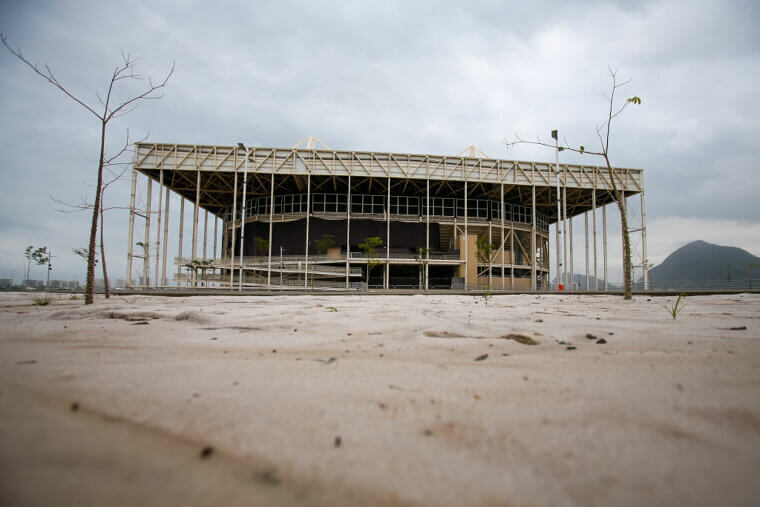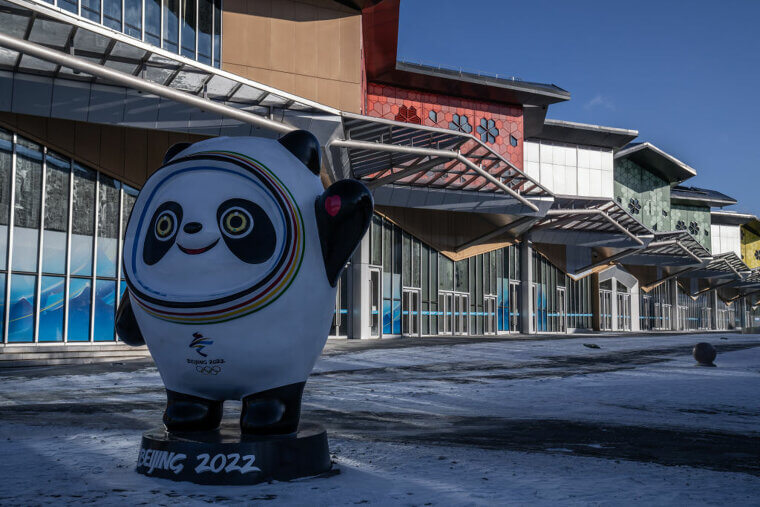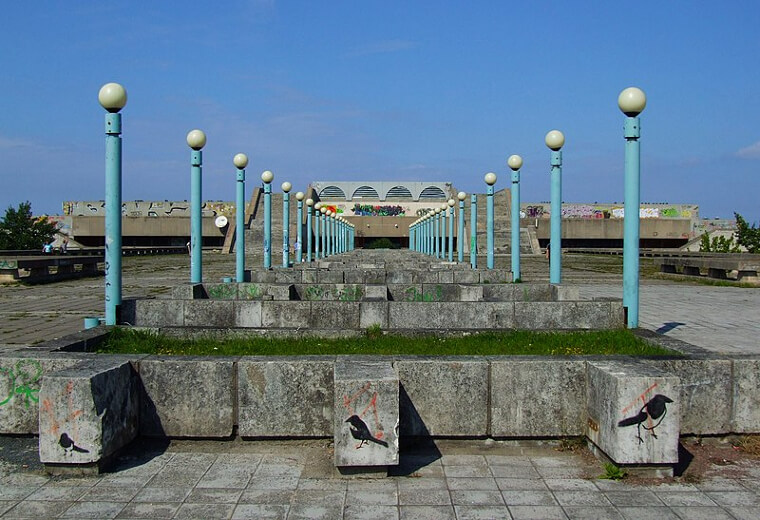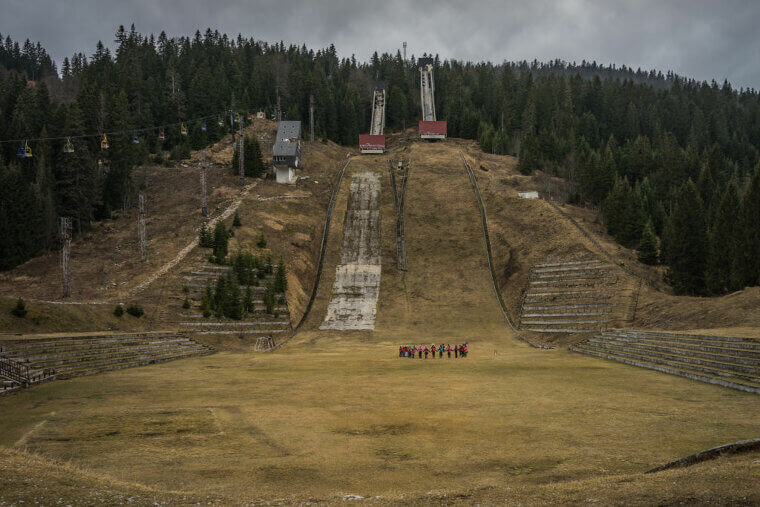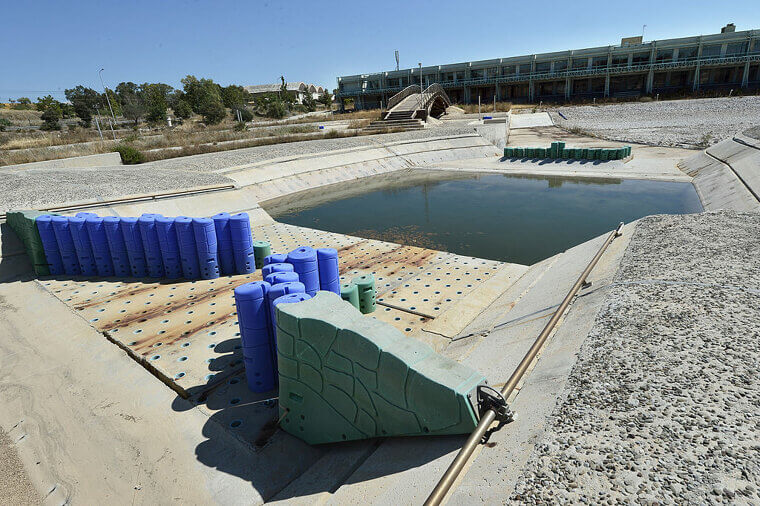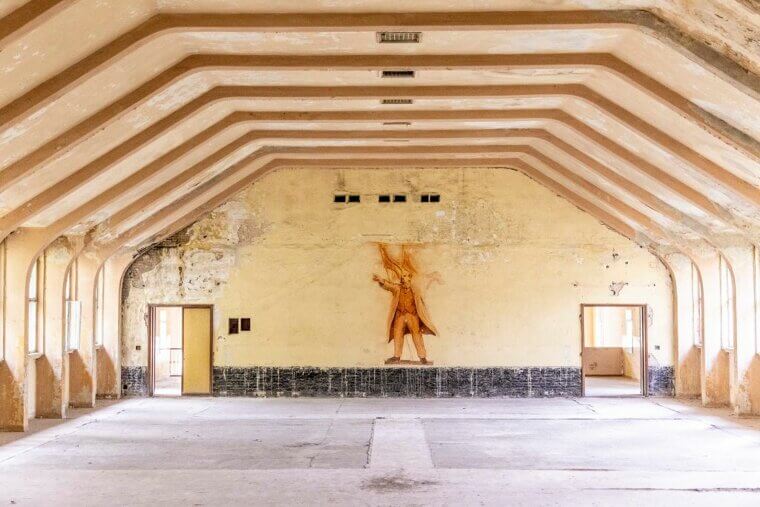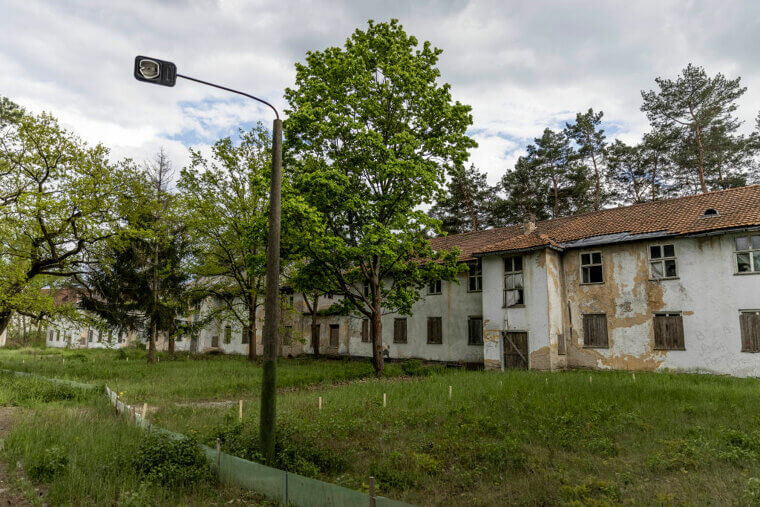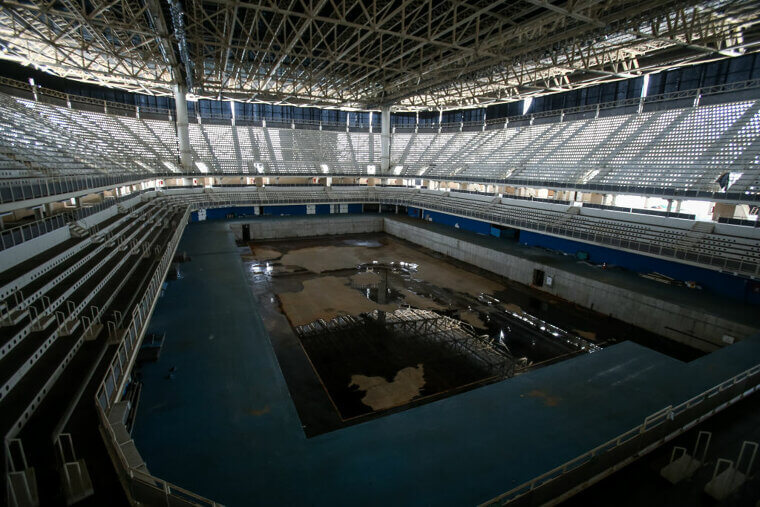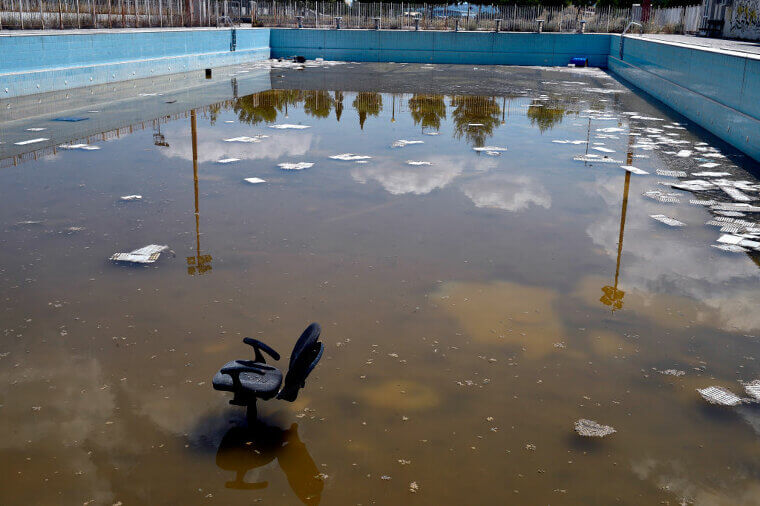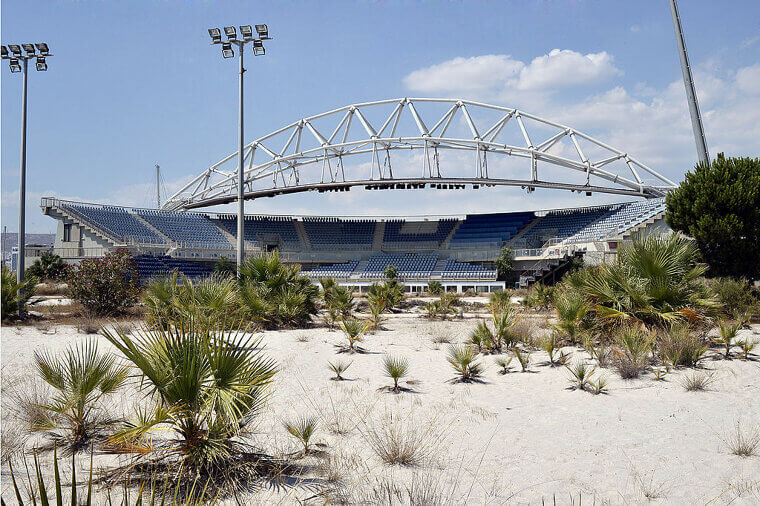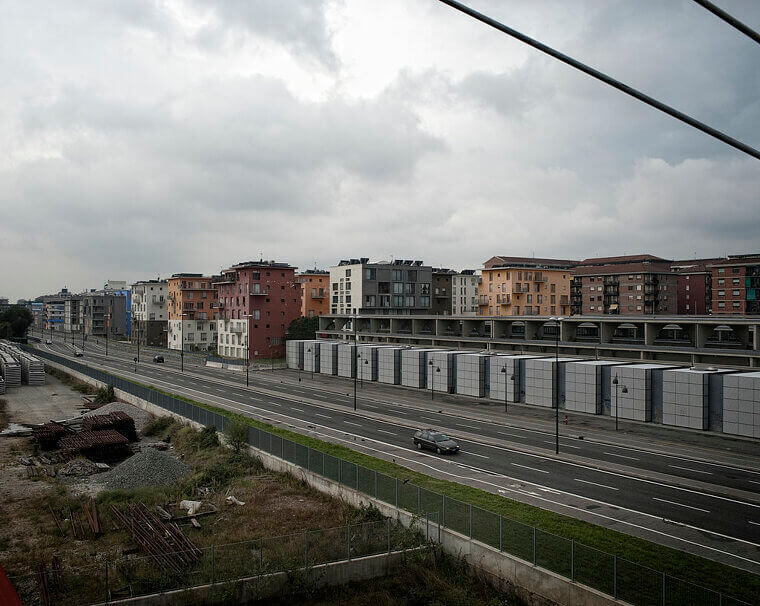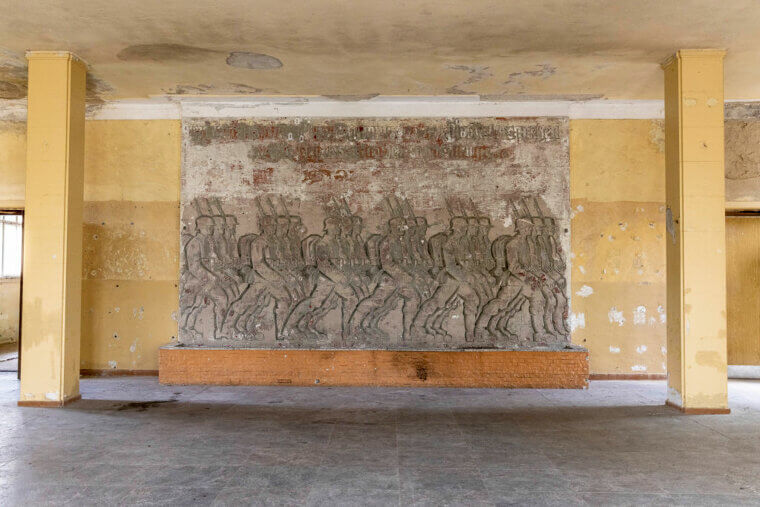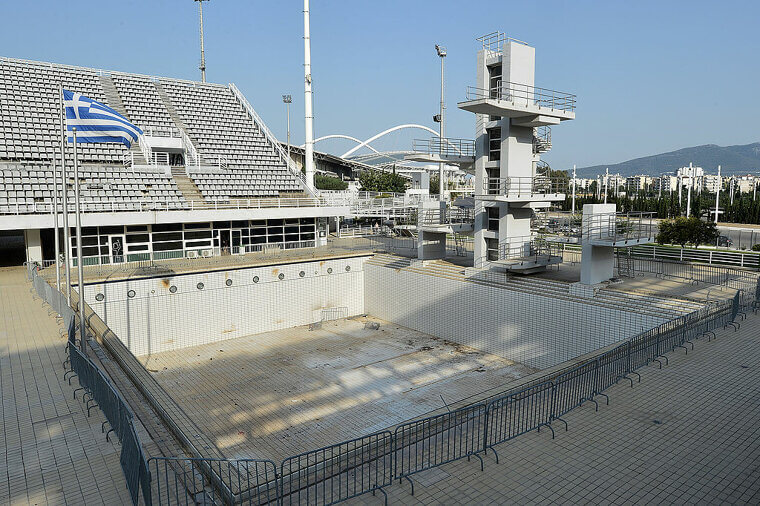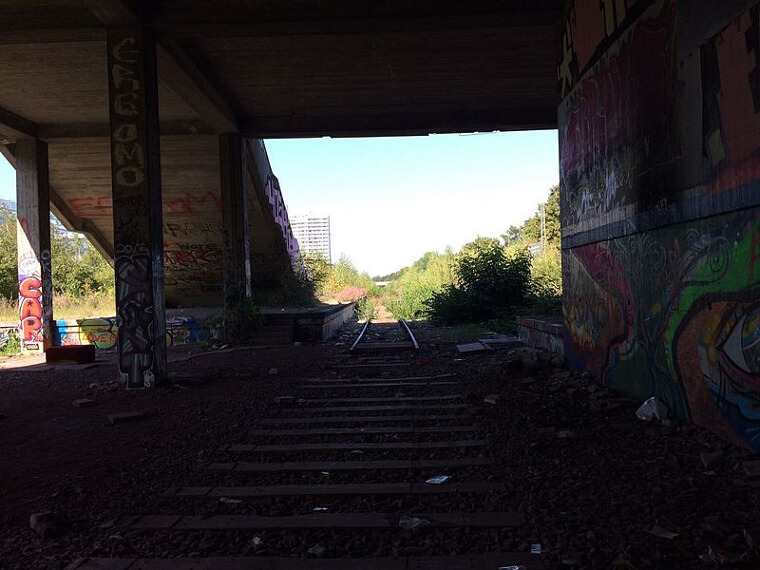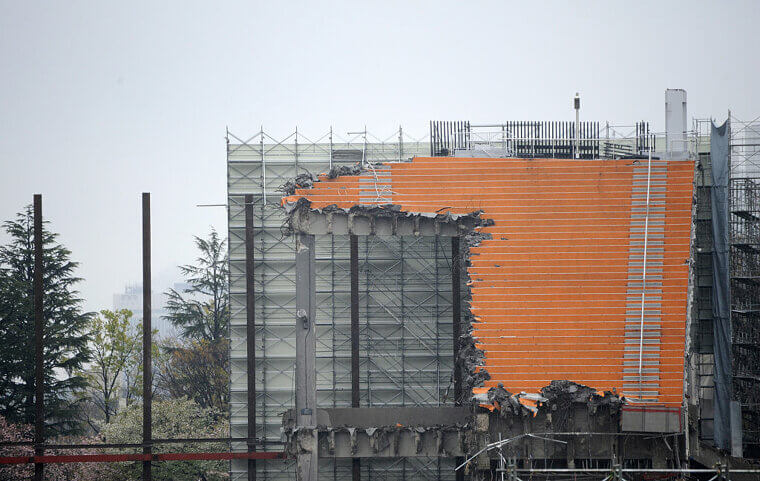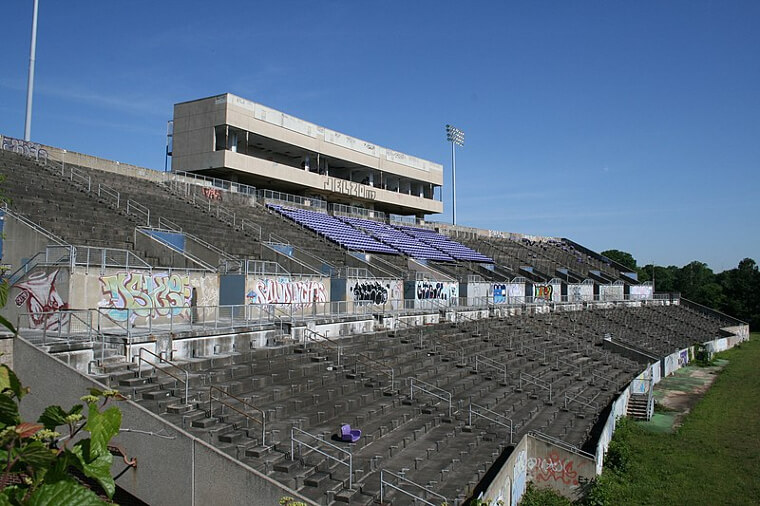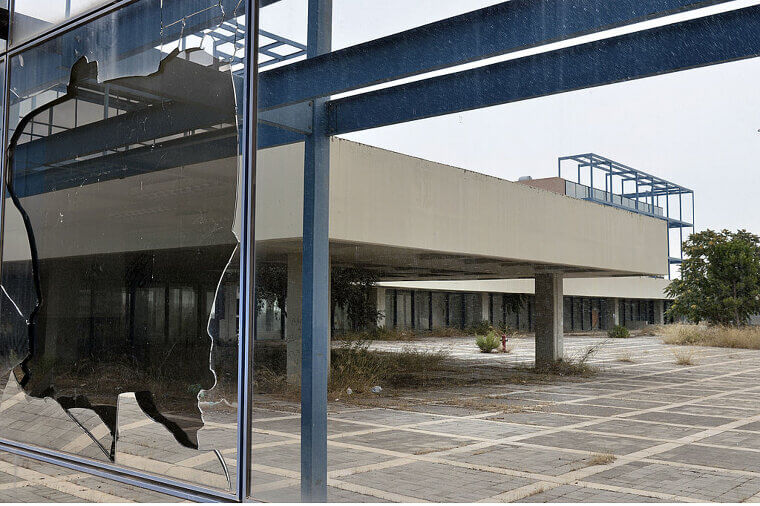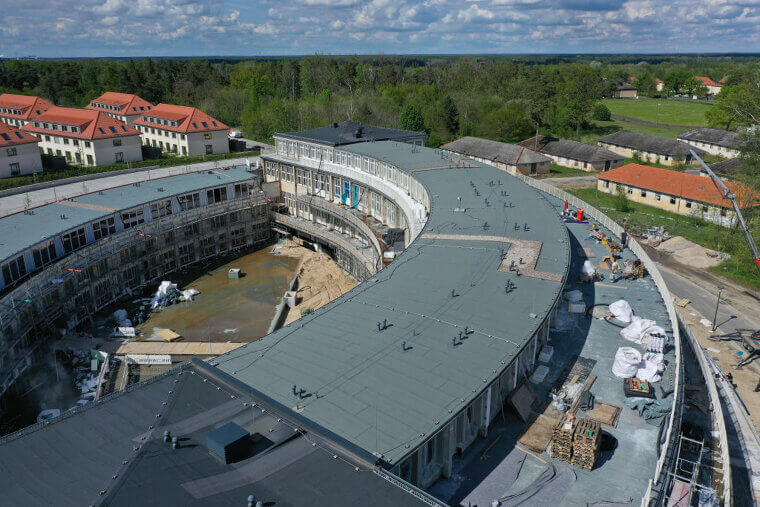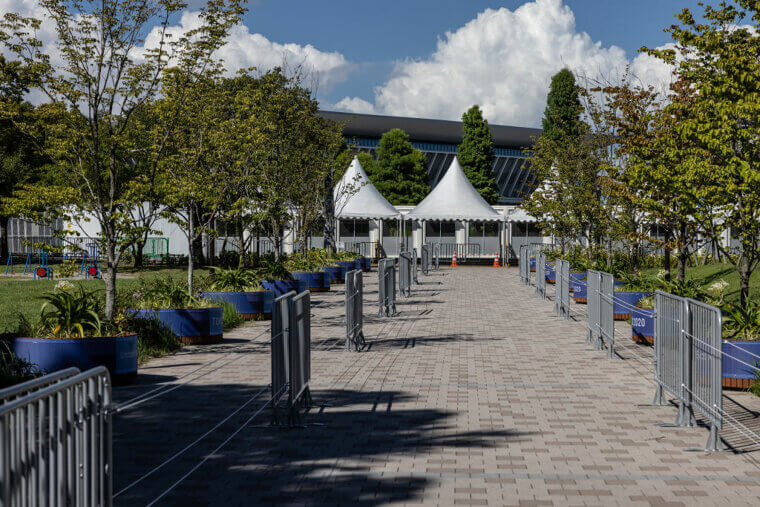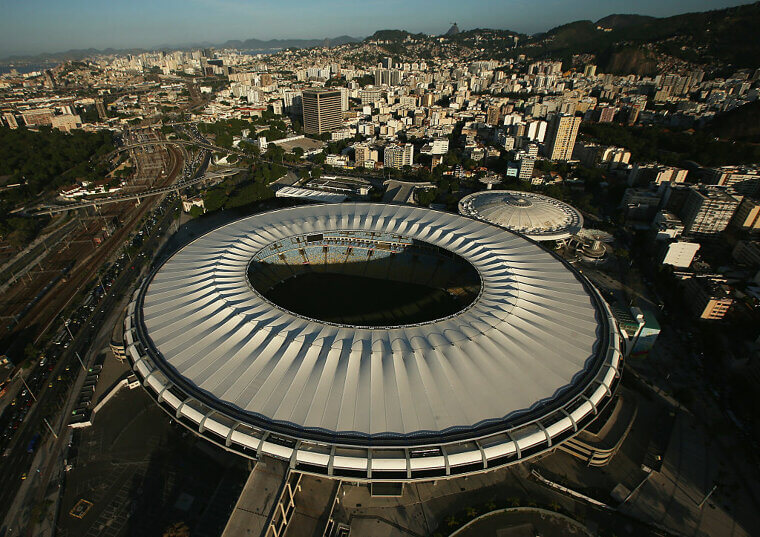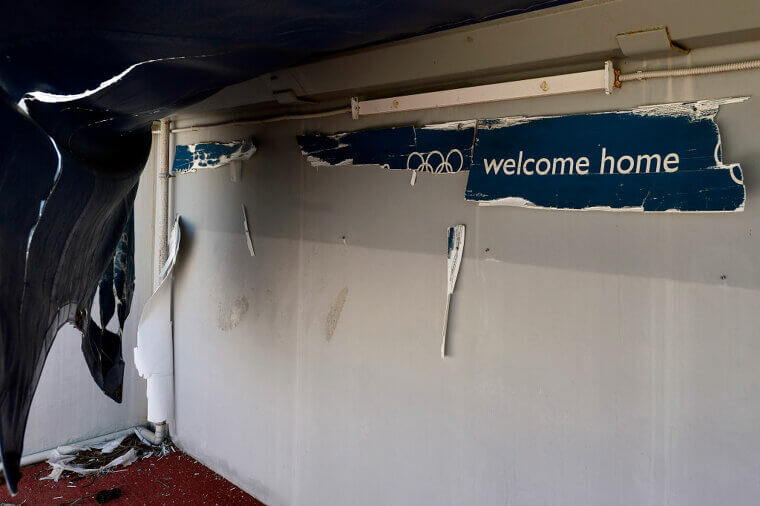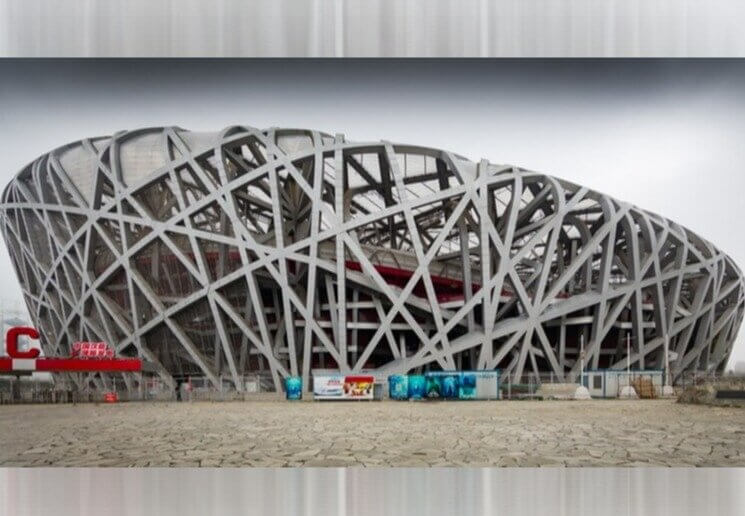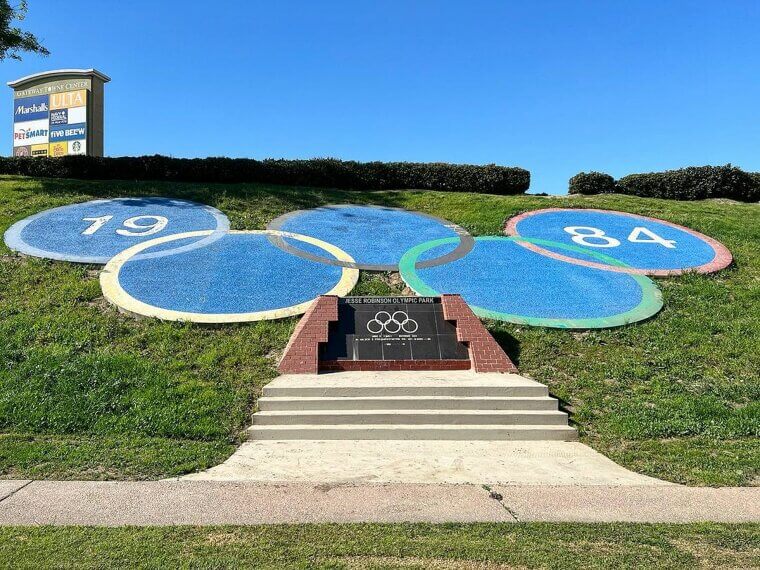Trampolino Olimpico Italia - Cortina D'ampezzo 1956
While we're graced with the Summer Games every four years, the same can be said for the Winter Games - which always takes place two years after the summer event. And in 1956, it was Italy's turn to host the Winter Olympics. Luckily, the country already had the Trampolino Olimpico Italia ski jump tower at their disposal - but they decided to give it a makeover a year before the 1956 Games to ensure it was up to Olympic standard.
The Trampolino Olimpico Italia was a hugely impressive feat of engineering that hosted numerous skiing events and catered for 40,000 sport-loving spectators. And while it stayed in action for a few decades after the Games, it was ultimately abandoned in 1990.
Aquatic Center - Athens 2004
2004 was a big year for the Olympic Games as Greece was given the chance to host it for the first time in over 100 years. As you can imagine, the Athens officials spared no expense when it came to preparing their city for the sporting event and it's reported that they spent over $11 billion on building venues and getting all of the infrastructure in place. Some of that money went to building the aquatics center.
Despite spending a huge amount of money on the outdoor aquatics center, choosing to build outdoor pools was an extremely controversial decision and was criticized by many. Because of this, it now lays abandoned.
Mount Trebevic Bobsled Course - Sarajevo 1984
Although most of the host cities for the Winter Olympics have the weather and the facilities for winter sports competitions, many venues are still bought specifically for the event. And this was the case for the Mount Trebevic Bobsled Course which was built in the mountains above Sarajevo specifically for the Sarajevo 1984 Winter Olympics. However, its sporting use ended straight after the games, and it was later used by the military during the Bosnian War from1992–95.
After that, however, it was abandoned and left to fall to pieces above the city. Some budding cyclists regularly make their way up the mountains to use it as their own personal track, though.
Hellinikon Olympic Softball Stadium - Athens 2004
If you're familiar with your Olympic history, you'll know that some sports go in and out of fashion. And while softball will be making a return to the Los Angeles 2028 Olympic Games, it hasn't been seen for a few years. In fact, one of the last times softball players competed in the Summer Games was in Athens 2004 - and the city even built the Hellinikon Olympic Softball Stadium specifically for softball and baseball events.
As soon as the Olympics came to an end, the city soon realized that they didn't have a use for a softball stadium anywhere, so they allowed nature to take over. Now, seats have been uprooted by trees, the pitch has been overtaken by weeds, and graffiti is everywhere.
Olympic Swimming Pool - Berlin 1936
Swimming pools at the Olympic Games aren't like the swimming pools you'll find at your local sports center. They are built with meticulous rules and regulations in place, and they are the exact size needed to ensure the swimmers can compete effectively. And for the Berlin 1936 Olympic Games, this swimming pool was built for the swimmers. In fact, it continued to be a competitive swimming pool and was even used in 1978 and 2015 for international competitions.
For the next year, it lay abandoned and fell into disarray. That was until 2016 when it was meticulously renovated and even upgraded to become a public swimming pool complete with slides and splash pools.
Tremplin Du Dauphine - Grenoble 1968
In 1968, Grenoble hosted the Winter Olympics, and a huge amount of preparation went into making it one of the best Winter Games the world has ever seen. In fact, officials built the Tremplin du Dauphine ski jump tower specifically for the worldwide sporting event and made sure that it had space for a whopping 50,000 spectators. And while it served the Winter Olympics well and continued to be use as a competitive ski jump for a while, it's since been overtaken by nature.
Although the Tremplin du Dauphine is still standing today, it hasn't been open to the public since 1992. That hasn't stopped curious visitors from spray painting graffiti or walking to the top, though.
Rio Media Center - Rio De Janeiro 2016
We wouldn't be able to enjoy the Olympic Games without the help of the media, and thousands of commentators, reporters, camera operators and more make their way to the host cities every four years. Of course, they need somewhere to go - and that place is normally a dedicated media center. For the Rio De Janeiro 2016 Olympics, they built a specific media center for the event that was later left abandoned after the closing ceremony.
For the next few months, the place was taken over by graffiti and trash, and eventually, the whole venue was declared a health hazard by the Brazilian government. So, it was torn down.
Olympic Mascots - Beijing 2008
No Olympic Games would be complete without some mascots. At the 2024 Paris Olympic Games, it was the controversial Phryge - but the options were a bit more recognizable during the Beijing 2008 Olympics. The mascots consisted of a few animals and an Olympic flame, and they were hugely popular during the event. When the Games were finished, however, they were tossed to the side and forgotten about for decades.
This can be seen in this photo, where some of the mascots lay abandoned on the outskirts of the Olympic Village, completely overtaken by the nature that's swallowing them up.
Linnahall Amphitheatre - Moscow 1980
Did you know that Russia has only ever hosted one Summer Olympic Games? That event took place back in 1980 when Moscow was the host city of the worldwide sporting event. And while the country already had a fair number of locations that were transformed into stadiums and facilities for the athletes, their families, and the spectators, Moscow did struggle to find a location for the sailing competition. So, they outsourced.
They decided to use the Linnahall Amphitheatre in Estonia for these events instead, under the guise that Moscow would take care of it over the coming years. However, it fell into disarray instead.
Mount Igman Ski Jump - Sarajevo 1984
The Mount Igman Ski Jump has had a very checkered past. Although it served as a very effective and handy venue for the Sarajevo 1984 Winter Olympics, it wasn't really needed when the worldwide event was over. However, its location proved to be extremely desirable during the 1992-95 Siege of Sarajevo. As a result, it became the sight of bloodshed and war. It's even been suggested that they used the medal podium as their execution spot.
Today, the ski jump location has become somewhat of a tourist attraction - despite the fact that it's in a state of disrepair. There are apparently some plans to bring it back to life, though.
Olympic Kayaking Slalom Course - Beijing 2008
The Olympic Games shine a light on often under-represented sports, and that's certainly true when it comes to the canoe and kayaking events. These are often fast-paced and chaotic and always take place in a dedicated venue that caters to the sport's requirements. Because of that, the officials behind the Beijing 2008 Olympics built this purpose-build kayaking slalom course for their event, and it was later used for the city's legendary Dragon Boat Festival four years later.
Since then, however, the venue hasn't been used much, and it's been abandoned. Thankfully, the water has now been drained - but there was once a time when it was thick with a layer of trash and algae.
Main Amphitheater - Berlin 1936
Although most of us will never have the chance to see inside an Olympic Village, these areas tend to have dorms for the athletes to sleep in, dining halls for them to eat in, and general common areas for them to relax and enjoy the experience. This was also the case during the Berlin Summer Olympics in 1936, when an amphitheater was built for the athletes to enjoy at their leisure.
Years after the Games ended, the amphitheater was then used by the military as a training center and a hospital, but now it simply lies abandoned and crumbling around itself.
Bobsleigh Track - Garmisch-Partenkirchen 1936
The Garmisch-Partenkirchen Winter Olympic Games in 1936 went down in history for many reasons. Of course, impressive sporting achievements were made in the Bavarian Alps, but this Games was also a chance for Hitler to spread his propaganda - which didn't go down well with the rest of the world. And when the Winter Games were over, many of the venues and much of the sporting equipment were left behind.
Although the bobsleigh track from the 1936 Winter Olympics was partially demolished three decades after the event came to a close, mementoes can still be found nearby. Including this old bobsleigh.
Olympic Village Housing - Berlin 1936
If you've ever been to Berlin, you'll recognize that this architecture is synonymous with the city. So, it should probably come as no surprise to hear that this was the housing for the Olympians at the Berlin 1936 Olympic Games. Blocks like these could be found all across the Olympic Village, with enough space to house all of the athletes throughout the duration of the prestigious and tiring worldwide event.
When the Games came to an end, however, there was just no use for this housing any longer. And instead of being demolished, they were left empty and abandoned for decades.
Olympics Aquatics Stadium - Rio De Janeiro 2016
While some venues at the Olympic Games are built for permanent use, many cities also choose to build temporary structures that can be demolished once the event is over. That's what officials at Rio De Janeiro did in 2016 for their aquatics stadium, and the structure they built was incredibly impressive. As well as housing thousands of spectators, the pool was also home to record-breaking achievements that have gone down in history.
Instead of being demolished completely after the Games, officials made the smart decision to manually dismantle it and use the materials to build other structures around the city. So, at least it didn't go to waste.
Olympic Swimming Pool - Athens 2004
Choosing to build outdoor swimming pools for the Athens 2004 Olympic Games was a controversial decision. While there's no doubt about the fact that the weather in Greece allows for outdoor events, Olympic swimming pools are typically built indoors to maintain constant temperatures that will allow the swimmers to perform at their best. Considering most people hated this swimming pool, it's no wonder that it was left abandoned after the Games.
Although the pool was eventually drained, rare rainstorms in Greece have turned the swimming pool into somewhat of a swamp. Plus, trespassers have covered the whole area with graffiti and trash.
Faliro Olympic Beach Volleyball Center - Athens 2004
Beach volleyball has always been a fairly popular sport for Olympic fans, but there's no denying that it requires a very specific stadium. After all, the whole thing needs to be turned into a makeshift beach for the players to enjoy. And while the Faliro Olympic Beach Volleyball Center at the Athens 2004 Olympics was equipped to house 9,000 spectators, officials soon realized that there wasn't much demand for beach volleyball stadiums after the Games came to an end.
Because of this, the whole stadium fell into disrepair and has since been overtaken by graffiti, weeds, and trash. It's not known what the city plans to do with it in the future.
Olympic Village - Turin 2006
One thing about the Winter Olympics is that the venues are almost always in place beforehand. After all, these Winter Games take place in skiing destinations where ski slopes, bobsled tracks, and mountain ranges are used on a regular basis. But for the Turin 2006 Olympic Games, officials knew that they'd need to build a designated Olympic Village for the athletes to eat, sleep, and relax in between their events.
So, they built the Olympic Village above - but abandoned it as soon as the Games were over. Since then, however, refugees from across the world have used it as a place of refuge.
Olympic Wall Decor - Berlin 1936
This photo captures a chilling scene from the Berlin Olympic Stadium, where a Nazi-era mural from the 1936 Olympics still clings to the wall. The bas-relief depicts marching soldiers, a stark reminder of the regime's propaganda that once permeated this grand event. The mural, now faded and crumbling, stands as a haunting relic of a dark chapter in history. The room surrounding it, with its peeling yellow paint and empty, echoing space, adds to the atmosphere of eerie abandonment.
This image not only reflects the passage of time but also the disturbing legacy of a stadium that once hosted one of history's most politically charged Olympic Games. The decaying mural is a poignant symbol of how the ideologies of the past can linger, even as the structures that housed them fall into ruin.
Olympic Village - Athens 2004
The fact that the officials behind the Athens 2004 Olympic Games spent so much money is something that they'll never be able to live down - especially as a huge chunk of their money went on venues and buildings that have since been abandoned and left to be claimed by nature. In fact, this photo was taken ten years after the Summer Games in 2014, and you can see just how damaged it's become.
Although the city could demolish the buildings and use the space for something else, it seems as though they just haven't gotten around to doing it. So, who knows how much longer they'll stand there.
Olympic Stadium Train Stop - Munich 1972
Building an Olympic Village and all of the stadiums to boot isn't as simple as building a few buildings. You also need to make sure that the infrastructure is in place to transport both the athletes and the spectators around - especially if the locations are spread out across a city. This was the case at the Munich 1972 Olympic Games, which is why officials built the Munchen Olympiastadion train stop on the Munich S-Bahn.
The station was officially closed in 1988, though, as it was disconnected from the main line and was no longer needed. It's still there, though, covered in graffiti and foliage.
National Olympic Stadium - Tokyo 1964
No Olympics venue would be complete without the main Olympic stadium. This is typically where the opening and closing ceremonies take place, and where all of the track and field events are hosted. And for the Tokyo 1964 Olympic Games, they used a site that had been built in 1958. The construction and aesthetic appeal of this venue proved to be so popular that it was used for decades after the Olympics for other sporting events.
In fact, it wasn't until 2019 that officials in Tokyo decided that it was time to give the stadium a refresh in time for the 2020 Olympics. So, the whole thing was demolished to make room for a new $1.9 billion stadium instead.
Herndon Stadium - Atlanta 1996
When the Atlanta Summer Games came around in 1996, the city largely made the most of venues that they already had at their disposal - one of which was the Herndon Stadium at Morris Brown College. Although the stadium was almost 50 years old at the time, the Olympic committee managed to turn it into a wonderful athletics venue for the Games and the college was proud to have it on their land.
But when the Games came to an end, and the venue struggled to find a use for itself, the stadium fell into disarray, and the college just couldn't afford to keep up with the maintenance. So, it now looks a little worse for wear.
Stone Mountain Tennis Center - Atlanta 1996
It costs a lot to bring the Olympic Games to life, and the city of Atlanta realized that for themselves when they hosted in 1996. And while they tried to use as many existing venues as possible, they also built new purpose-built structures for the prestigious event - including the Stone Mountain Tennis Center which cost a whopping $22 million to build. And while it was also used after the Olympics for making tennis events, it closed up shop in 2007.
The courts spent the next decade gathering dust, falling apart, and being overtaken by weeds. And it wasn't until 2017 that the city eventually decided to cut their losses and demolish the whole thing.
The Olympic Village - Berlin 1936
While every Olympic Games goes down in history in its own right, there's no doubt that the Berlin 1936 Games were infamous. This was the year that Adolf Hitler used the worldwide event to push his antisemitic agenda on the masses - but also the year that some courageous athletes pushed back against his prejudice. And when they weren't doing that, these athletes stayed in the Olympic Village as seen below.
The Olympic Village was purpose-built for the event and can still be found in West Berlin, but it's definitely seen better days. Although it was used as a hospital and military school for a time, it was then left abandoned and overtaken by nature.
Fan Park - Tokyo 2020
The Tokyo 2020 Olympics took place at unprecedented times when the COVID-19 pandemic was still in full swing. And while there were calls on Tokyo and the Olympic Committee to cancel the event, they decided to go ahead with it without any spectators, with mask mandates in place and social distancing rules. However, officials had already built this fan park before the pandemic reared its head. Because of this, it lay empty during the Games.
The structure also stood empty for many months after the Olympics came to a close, but it's thought that it's since been torn down as it fell into a state of disarray.
Maracana Stadium - Rio De Janeiro 2016
As Rio De Janeiro was gearing up for the 2016 Olympic Games, they had to decide which venues to use for the event. Of course, the Maracana Stadium was a no-brainer, as it had already played host to the Pan American Games, World Cup soccer matches, and music concerts. And while it served an impressive purpose during the Summer Olympics, things turned sour almost as soon as the closing ceremony came to an end.
Officials who organized the Olympics and the owners of the stadium soon entered into a bitter battle over who would take care of the stadium. And when they couldn't come to an agreement, they left it abandoned.
Faliro Olympic Beach Volleyball Center - Athens 2004
While many Olympic events take place outdoors - like tennis matches, athletics races, showjumping, and beach volleyball - the cities behind these Summer Games also make sure that there are indoor areas nearby. This allows the athletes to mentally prepare themselves for their event and gives spectators a chance to hang out before they get in their seats. This was the case at the Faliro Olympic Beach Volleyball Center from Athens 2004, too.
Just a short walk away from the sandy volleyball court were the indoor areas of the stadium, which have fallen into complete disrepair over the years. After all, it's been left to its own devices.
Beijing National Stadium - Beijing 2008
If you watched the 2008 Summer Olympics, you'll know that this particular venue became synonymous with the worldwide Olympics. Nicknamed "The Bird's Nest," the whole stadium was an architectural marvel and went down a storm with those who competed inside of it and the spectators who got to sit inside of it. This 90,000-seater stadium wasn't cheap to build, though, and cost a whopping $428 million to construct in time for the Olympics.
For many years after the Games ended, the stadium fell into a state of disarray. But it's been noted that the government is piling even more money into restoring it to its former glory.
Jesse Robinson Olympic Park - Los Angeles 1984
There's a high chance that you might already be familiar with the Jesse Robinson Olympic Park. And while this park didn't play a huge part in the Los Angeles 1984 Summer Games, the significance of the park is still widely remembered across the globe. After all, this park was named after Olympic track star Jesse Robinson who grew up in Compton and spent the later part of his career helping out the community in his hometown.
When the Olympics were announced, he asked Olympic officials whether Compton could play a part in the prestigious event and so they built this park in his honor. Today, it's definitely not as beautiful as it once was.

